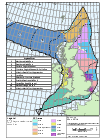Offshore Energy Strategic Environmental Assessment (SEA): An overview of the SEA process
An explanation of the offshore SEA process, including documentation of the most recent assessment and related consultation.
Overview
Strategic Environmental Assessment (SEA) is the process of appraisal through which environmental protection and sustainable development may be considered, and factored into national and local decisions regarding Government (and other) plans and programmes – such as oil and gas licensing rounds and other offshore energy developments, including renewables and gas and carbon dioxide storage.
The SEA process and legislative context
The SEA process aims to help inform ministerial decisions through consideration of the environmental implications of the outcome of a proposed plan/programme. The Department for Energy Security & Net Zero (DESNZ)(DESNZ) formerly DTI, BERR, DECC and BEIS (the department), as the principal environmental regulator of the offshore oil and gas industry, has taken a proactive stance on the use of SEA as a means of striking a balance between promoting economic development of the UK’s offshore energy resources and effective environmental protection. Although the European Strategic Environmental Assessment Directive (Directive 2001/42/EC) was not incorporated into UK law until 2004 (The Environmental Assessment of Plans and Programmes Regulations 2004, and equivalent Regulations of the devolved administrations (the SEA Regulations)), SEAs have been carried out since 1999 in accordance with its requirements.
The SEA Regulations set out the information to be included in the environmental report of the Strategic Environmental Assessment, namely:
- An outline of the contents, main objectives of the plan or programme and relationship with other relevant plans and programmes.
- The relevant aspects of the current state of the environment and the likely evolution thereof without implementation of the plan or programme.
- The environmental characteristics of areas likely to be significantly affected.
- Any existing environmental problems which are relevant to the plan or programme including, in particular, those relating to any areas of a particular environmental importance, such as areas designated pursuant to Directives 2009/147/EC and 92/43/EEC (the Birds and Habitats Directives).
- The environmental protection objectives, established at international, Community or member state level, which are relevant to the plan or programme and the way those objectives and any environmental considerations have been taken into account during its preparation.
- The likely significant effects on the environment, including issues such as biodiversity, population, human health, fauna, flora, soil, water, air, climatic factors, material assets, cultural heritage including architectural and archaeological heritage, landscape and the inter-relationship between the above factors.
- The measures envisaged to prevent, reduce and, as fully as possible, offset any significant adverse effects on the environment of implementing the plan or programme.
- An outline of the reasons for selecting the alternatives dealt with and a description of how the assessment was undertaken, including any difficulties (such as technical deficiencies or lack of know-how) encountered in compiling the required information.
- A description of the measures envisaged concerning monitoring.
- A non-technical summary of the information provided under the above headings.
These effects should include secondary, cumulative, synergistic, short, medium and long term, permanent and temporary, positive and negative effects.
The department undertook a sequence of oil and gas SEAs considering various areas of the UKCS (SEA areas 1-8), in addition to an SEA for Round 2 wind leasing. The more recent offshore energy SEAs (OESEA, OESEA2, OESEA3 and OESEA4)OESEA4) incorporated the entire UKCS (with the exception of Northern Ireland and Scottish territorial waters for renewable energy, and Scottish territorial waters for carbon dioxide transport and storage), for technologies including oil and gas exploration and production, gas storage and offloading including carbon dioxide transport and storage, renewable energy (including wind, wave and tidal power), and offshore hydrogen production and transport. A summary of the areas covered by previous SEAs, when they were undertaken and for which sectors, and an overview of each of the technologies covered by the latest offshore energy plan/programme is provided in the documents below.
| SEA | Area | Sectors covered | Licensing/leasing round |
|---|---|---|---|
| SEA 1 | The deep water area along the UK and Faroese boundary | Oil & Gas | 19th Round (2001) |
| SEA 2 | The central spine of the North Sea which contains the majority of existing UK oil and gas fields | Oil & Gas | 20th Round (2002) |
| SEA 2 extension | Outer Moray Firth | Oil & Gas | 20th Round (2002) |
| SEA 3 | The remaining parts of the southern North Sea | Oil & Gas | 21st Round (2003) |
| R2 | Three strategic regions off the coasts of England and Wales in relation to a second round of offshore wind leasing | Offshore wind | Round 2 (2003) |
| SEA 4 | The offshore areas to the north and west of Shetland and Orkney | Oil & Gas | 22nd Round (2004) |
| SEA 5 | Parts of the northern and central North Sea to the east of the Scottish mainland, Orkney and Shetland | Oil & Gas | 23rd Round (2005) |
| SEA 6 | Parts of the Irish Sea | Oil & Gas | 24th Round (2006) |
| SEA 7 | The offshore areas to the west of Scotland | Oil & Gas | 25th Round (2008) |
| OESEA | UK offshore waters and territorial waters of England and Wales | Oil & Gas, Offshore wind | 26th Round/Round 3 (2009) |
| OESEA2 | UK offshore waters and territorial waters of England and Wales | Oil & Gas, Offshore wind, wave and tidal, gas and carbon dioxide storage | 27th Round (2011) 28th Round (2014) |
| OESEA3 | UK offshore waters and territorial waters of England and Wales | Oil & Gas, Offshore wind, wave and tidal, gas and carbon dioxide storage | 29th Round (2016) Supplementary Round (2016) 30th Round (2017) 31st Round (2018) 31st Supplementary Round (2019) 32nd Round (2020) |
| OESEA4 | UK offshore waters and territorial waters of England and Wales | Oil & Gas, Offshore wind, wave and tidal, gas and carbon dioxide storage, hydrogen production |






